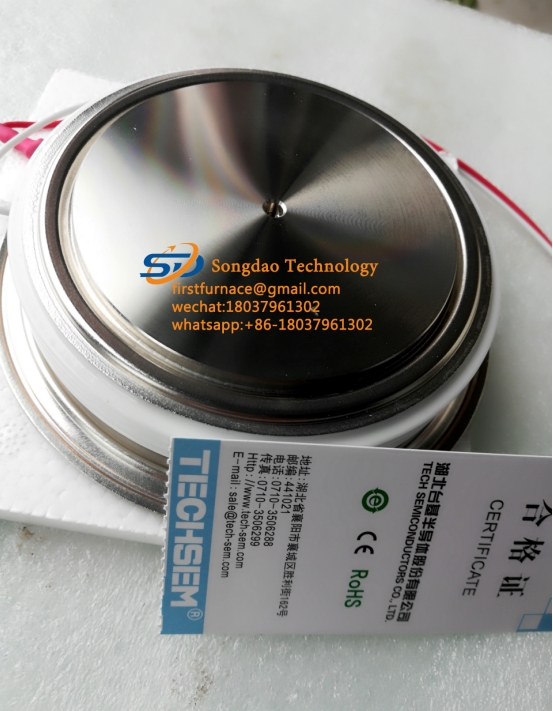- 30
- Sep
The working principle of induction melting furnace accessories:thyristor
The working principle of induction melting furnace accessories: thyristor
In the working process of the thyristor T, its anode A and cathode K are connected with the power supply and load to form the main circuit of the thyristor, and the gate G and cathode K of the thyristor are connected with the device for controlling the thyristor to form the control circuit of the thyristor.
Working conditions of thyristor:
1. When the thyristor is subjected to a positive anode voltage, the thyristor is turned on only when the gate is subjected to a positive voltage. At this time, the thyristor is in a forward conduction state, which is the thyristor’s thyristor characteristic, which can be controlled.
2. When the thyristor is turned on, as long as there is a certain positive anode voltage, regardless of the gate voltage, the thyristor remains on, that is, after the thyristor is turned on, the gate loses its function. The gate only serves as a trigger
3. When the thyristor is turned on, when the main circuit voltage (or current) decreases to close to zero, the thyristor turns off.
4. When the thyristor bears the reverse anode voltage, no matter what voltage the gate bears, the thyristor is in the reverse blocking state.
In the intermediate frequency furnace, the rectifier side shut-off time is within KP-60 microseconds, and the inverter side shuts off for a short time within KK-30 microseconds. This is also the main difference between KP and KK tubes. Thyristor T is its anode during operation. A and cathode K are connected with the power supply and load to form the main circuit of the thyristor. The gate G and cathode K of the thyristor are connected with the device for controlling the thyristor to form the control circuit of the thyristor.
From the internal analysis of the working process of the thyristor: The thyristor is a four-layer three-terminal device. It has three PN junctions, J1, J2, and J3. Figure 1. The NP in the middle can be divided into two parts to form a PNP-type transistor and an NPN-type transistor. Figure 2 When the thyristor bears the positive anode voltage, in order to make the thyristor conduct the copper, the PN junction J2 that bears the reverse voltage must lose its blocking effect. The collector current of each transistor in the figure is also the base current of another transistor.
Therefore, when there is enough gate current Ig to flow in two transistor circuits that are compounded with each other, a strong positive feedback will be formed, causing the two transistors to be saturated and conduction, and the transistors are saturated and conduction. Suppose the collector current of the PNP tube and the NPN tube are corresponding to Ic1 and Ic2; the emitter current is corresponding to Ia and Ik; the current amplification coefficient is corresponding to a1=Ic1/Ia and a2=Ic2/Ik, and the reverse phase flowing through the J2 junction The leakage current is Ic0, and the anode current of the thyristor is equal to the sum of the collector current and the leakage current of the two tubes: Ia=Ic1 Ic2 Ic0 or Ia=a1Ia a2Ik Ic0 If the gate current is Ig, the thyristor cathode current is Ik=Ia Ig, thus It can be concluded that the anode current of the thyristor is: I=(Ic0 Iga2)/(1-(a1 a2)) (1-1) The corresponding current amplification coefficients a1 and a2 of the silicon PNP tube and silicon NPN tube are proportional to the emitter current The change and the sharp change are shown in Figure 3.
When the thyristor is subjected to positive anode voltage and the gate is not subjected to voltage, in formula (1-1), Ig=0, (a1 a2) is very small, so the anode current of the thyristor Ia≈Ic0 and the thyristor is closed at positive To the blocking state. When the thyristor is at the positive anode voltage, the current Ig flows from the gate G. Since the large enough Ig flows through the NPN tube’s emission junction, the initial current amplification factor a2 is increased, and a large enough electrode current Ic2 flows through the PNP tube. It also increases the current amplification factor a1 of the PNP tube, and produces a larger electrode current Ic1 that flows through the emitter junction of the NPN tube.
Such a strong positive feedback process proceeds quickly.
When a1 and a2 increase with the emitter current and (a1 a2) ≈ 1, the denominator 1-(a1 a2) ≈ 0 in formula (1-1), thus increasing the anode current Ia of the thyristor. At this time, it flows through The current of the thyristor is completely determined by the voltage of the main circuit and the circuit resistance. The thyristor is already in a forward conducting state. In formula (1-1), after the thyristor is turned on, 1-(a1 a2)≈0, even if the gate current Ig=0 at this time, the thyristor can still maintain the original anode current Ia and continue to conduct.
After the thyristor is turned on, the gate has lost its function. After the thyristor is turned on, if the power supply voltage is continuously reduced or the loop resistance is increased to reduce the anode current Ia to below the maintenance current IH, because a1 and a1 drop rapidly, when 1-(a1 a2) ≈ 0, The thyristor returns to the blocking state.

